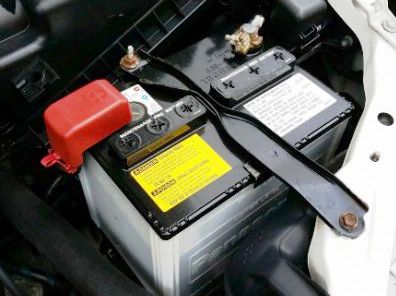On occasion, a battery may experience significant drain long after the engine has been shut off. The result can often lead to a flat, caused not by a faulty battery or through something obvious like the headlights being left on. It typically happens due to a short circuit that can be tricky to pin down.
This is known as parasitic draw. A certain amount of draw is normal – in the region of 25mA (milliamps) – but if you have 100mA or more being lost, something is up.
It could be anything from a dimming dome light staying awake or glove compartment switch sticking on, to faulty aftermarket radio or alarm wiring. In addition, any number of fancy electronics systems that are installed on newer cars could be playing up, such as your GPS or proximity key system.
What You’ll Need
A digital multimeter is best for this test as opposed to an analog one, which is not as accurately read. A DMM with the ability to measure continuous current to 10A will be fine in most cases, though one rated 20A would be less prone to blowing a fuse. You also need a milliamp range for higher resolution to pick up minimal current draw as most faults tend to be of the trickle variety.
You can buy fairly cheap, half-decent multimeters these days, but bearing in mind that the cheapo, no-name ones are not known for their quality or input protection. It is best to stick with a brand name, though you don’t necessarily have to go with a top branded Fluke model.
Procedure
Step 1: Prepare for Test You should have a fully charged battery before starting – voltage would be around 12.6V for a good one. Be sure to close all doors, turn off the radio and disconnect accessories, such as smartphones and add-on GPS devices. Even a key in the ignition can have systems waking up on newer cars that will initiate draw.
Step 2: Disconnect the Battery Pop the hood and disconnect the negative cable from the negative battery terminal. It is always best to do a parasitic draw test from the negative side so there is no chance of accidentally shorting should you test from the positive side.

Step 3: Connect the Multimeter Plug the black probe into the common (COM) jack input of the multimeter and the red probe into the amps (usually A) jack input. Then connect the red probe to the previously disconnected negative cable of the car loom, and the black able onto the battery terminal.
Note: in order to test for current, the multimeter must be connected in series with the circuit as it needs to gauge electron flow, so to speak. Voltage, on the other hand, is measured in parallel.
Step 4: Give the Car Time to Sleep Modern car systems may ‘wake up’ when you connect a multimeter in such a fashion as it picks up the power of its batteries. So wait a few minutes before conducting the draw test.
CAUTION: when connected, avoid starting the engine or even turning on the headlights as this will likely blow a fuse in the multimeter. Vehicle batteries put out a lot of amps due to being low voltage.
Step 5: Reading the Meter Newer, auto ranging multimeters will automatically select the correct range of a signal they pick up. On manual ranging meters, you will need to select a range, usually either 2A or 200mA. If you get ‘OL’ on the screen, it means over limit and you should select a higher range.
If you see a reading of around 50mA and above on a standard car, it generally means something is drawing power and you likely have parasitic draw. Just note that if you have a big, modern, luxury car its added computerized systems will likely increase the natural current draw. In this instance, the threshold might be 100mA.
PARASITIC DRAW ESTABLISHED
It is now time to see what is causing the draw. The tried and tested method is to start pulling fuses to see which circuit is the culprit. [For testing newer vehicles with complex systems, see below for a different method].
Step 6: Pulling Fuses Locate the fuse panel(s) and start pulling out fuses one after the other, taking notice of any drop in the reading on the multimeter. If there is no joy with the fuses, start removing the relays. For those fuse boxes that are inside the vehicle, a tip is to lay the meter on the windshield facedown so you can see the display.

Step 7: Narrowing Down When the display drops to a nominal mA draw, note the fuse/relay position number and check the vehicle’s manual. There is often more than one circuit on a given fuse, so you would then need to eliminate each one, such as remove a bulb or unplug a heater.
Step 8: Repair and Reconnect When the meter drops down to 25mA or less after removing the offending fuse, bulb or unplugging a circuit, you likely have your culprit. Repair the fault/replace the item and run another test to be sure. If you’re confident there are no other faults, reconnect the battery.
Alternator fault?: if you’ve gone through all fuses and relays (and checked for other fuse boxes), oftentimes the alternator can be at fault. One of the diodes may have shorted out and caused current to drain back to the battery. Test it with the multimeter before and after unplugging.
Parasitic Draw Test on Newer Cars
Some of newer vehicles can be a real pain to diagnose parasitic draw test with a multimeter due to all the added electrical circuits, computers and control modules. You have electric mirrors, heated memory seats, GPS, trackers, and a slew of gadgets. Some of these systems are interlinked, exacerbating the problem.
Even car keys can indirectly cause current drain. Proximity keys are designed to wake up a car’s locking mechanism when they are within close proximity so that you can unlock and open the door without the key. This is great in normal conditions, say, at your house, but can be an issue in practice. If you park in an area where lots of other cars have these systems, for example, the computer may wake up every time their drivers walk past your car. In this scenario, you may need to disable the sensor. More on this issue…
Old vs New Method
The old method detailed above – disconnecting the battery, putting the multimeter in series and pulling fuses until you find the draw – might not work as effectively on these cars. This is because the very disconnecting of the battery may temporarily fix the issue by sending the system to sleep along with the error. You don’t want this; you want the fault to keep drawing current so you can diagnose it on your meter.
An alternative is to thus diagnose parasitic draw by measuring voltage drop across the fuses. You can do this in-situ as auto fuses have open test points on them, so no need to remove them or disconnect the battery. What you are looking for is a voltage drop in the millivolts range. It is caused by an increase in resistance brought about by the heating of the fuse through movement of current.
Different size fuses will show a different voltage drop, but all of the same rating will have roughly the same resistance, so it is easy to get a reference by testing one 10A fuse against the next. As an example, a 10A fuse with 1A flowing through it might show a voltage drop of 5mV. If you were to measure the same fuse with no current flow, it would be more like 0.1mV or 0.2mV. Quite significant and easy to spot.
Procedure
- Drive the car and operate all circuits – wipers, heater, seats, windows, GPS, lights, sat-nav etc – and then return and remove the key.
- Consult the manual on how long it takes for the various systems to sleep.
- Be sure to tape down the driver door switch that operates the dome light and leave the car unlocked so you don’t end up switching on any systems upon reentering.
- Carry out the testing of each fuse and note any spurious voltage drop.
Other vehicles: the above also works for motorcycles and other vehicles, with a similar process.
Key to Better Battery Life
Along with being a nuisance and potentially leaving you stranded, even minimal draw can wear down a vehicle’s battery over time, often leading to performance issues and possibly a slow death. The key to good battery life is to nip any parasitic draws in the bud and also ensure the battery keeps charge above 12.4V.
Vehicles that only see occasional use are more prone to losing charge, where sulfation further compromises performance and longevity. Those driven daily have the benefit of the alternator to maintain charge, and when you test the voltage and current frequently, you can pick up any potential issues early.
Conclusion
Parasitic draw on one’s vehicle can be a nightmare and often happens at the most inopportune time. But it needn’t be the mammoth task you initially envisioned and is wholly within the realm of the layman, as long as there is a multimeter to hand. You can take great satisfaction in diagnosing the fault yourself and potentially save hundreds of dollars in the process.
See here how to check battery charge
Choosing a Multimeter
There are a slew of multimeters on the market, from cheap Chinese-made testers and Craftsmans up to high-end Flukes. A basic device is all you’d need for a parasitic draw test with a multimeter. Just make sure it can test amperage, has an auto ranging mode, and is at least a known brand.
US brand INNOVA makes decent multimeters for automotive tasks, such as the 3340 or cheaper 3320, but even a standard electrician’s multimeter can do the trick. Do spend a bit of time going over the specs to ascertain functions and the electronic input protection. This is especially important for the multimeter and your health. Both meters mentioned are not fused on the 10A input, for example, whereas the Fluke 77 IV is.



![How to fix error 0xc000000e windows 10 2022 100 SOLVED 7 How to fix error 0xc000000e windows 10 2022: [100% SOLVED]](https://dreamcheeky.com/wp-content/uploads/2022/06/How-to-fix-error-0xc000000e-windows-10-2022-100-SOLVED.jpg)
![how to fix Error code 0xc0000001 2022 100 FIXED 8 how to fix Error code 0xc0000001 2022 :[100% FIXED]](https://dreamcheeky.com/wp-content/uploads/2022/06/how-to-fix-Error-code-0xc0000001-2022-100-FIXED.jpg)